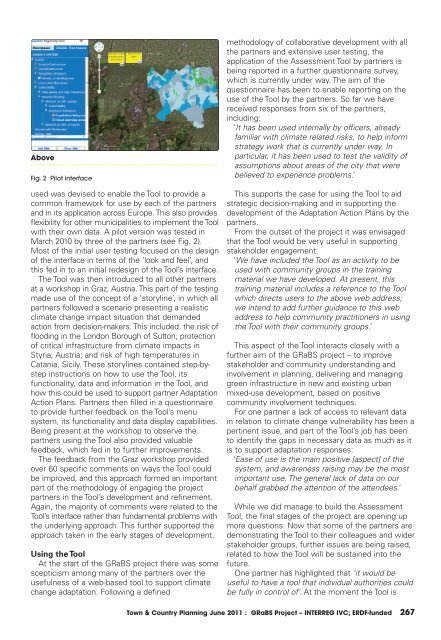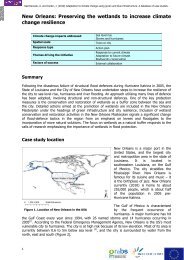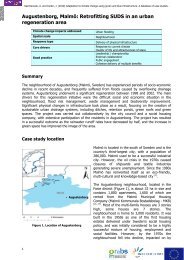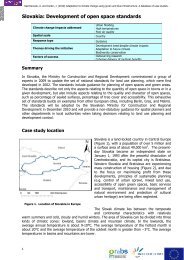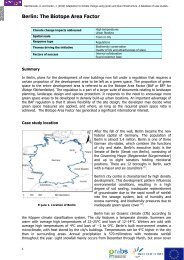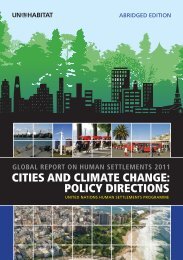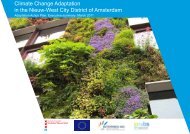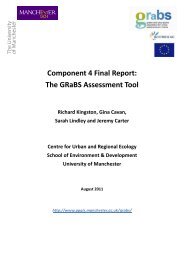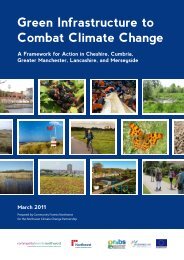Download - GRaBS
Download - GRaBS
Download - GRaBS
Create successful ePaper yourself
Turn your PDF publications into a flip-book with our unique Google optimized e-Paper software.
Above<br />
Fig. 2 Pilot interface<br />
used was devised to enable the Tool to provide a<br />
common framework for use by each of the partners<br />
and in its application across Europe. This also provides<br />
flexibility for other municipalities to implement the Tool<br />
with their own data. A pilot version was tested in<br />
March 2010 by three of the partners (see Fig. 2).<br />
Most of the initial user testing focused on the design<br />
of the interface in terms of the ‘look and feel’, and<br />
this fed in to an initial redesign of the Tool’s interface.<br />
The Tool was then introduced to all other partners<br />
at a workshop in Graz, Austria. This part of the testing<br />
made use of the concept of a ‘storyline’, in which all<br />
partners followed a scenario presenting a realistic<br />
climate change impact situation that demanded<br />
action from decision-makers. This included: the risk of<br />
flooding in the London Borough of Sutton; protection<br />
of critical infrastructure from climate impacts in<br />
Styria, Austria; and risk of high temperatures in<br />
Catania, Sicily. These storylines contained step-bystep<br />
instructions on how to use the Tool, its<br />
functionality, data and information in the Tool, and<br />
how this could be used to support partner Adaptation<br />
Action Plans. Partners then filled in a questionnaire<br />
to provide further feedback on the Tool’s menu<br />
system, its functionality and data display capabilities.<br />
Being present at the workshop to observe the<br />
partners using the Tool also provided valuable<br />
feedback, which fed in to further improvements.<br />
The feedback from the Graz workshop provided<br />
over 60 specific comments on ways the Tool could<br />
be improved, and this approach formed an important<br />
part of the methodology of engaging the project<br />
partners in the Tool’s development and refinement.<br />
Again, the majority of comments were related to the<br />
Tool’s interface rather than fundamental problems with<br />
the underlying approach. This further supported the<br />
approach taken in the early stages of development.<br />
Using the Tool<br />
At the start of the <strong>GRaBS</strong> project there was some<br />
scepticism among many of the partners over the<br />
usefulness of a web-based tool to support climate<br />
change adaptation. Following a defined<br />
methodology of collaborative development with all<br />
the partners and extensive user testing, the<br />
application of the Assessment Tool by partners is<br />
being reported in a further questionnaire survey,<br />
which is currently under way. The aim of the<br />
questionnaire has been to enable reporting on the<br />
use of the Tool by the partners. So far we have<br />
received responses from six of the partners,<br />
including:<br />
‘It has been used internally by officers, already<br />
familiar with climate related risks, to help inform<br />
strategy work that is currently under way. In<br />
particular, it has been used to test the validity of<br />
assumptions about areas of the city that were<br />
believed to experience problems.’<br />
This supports the case for using the Tool to aid<br />
strategic decision-making and in supporting the<br />
development of the Adaptation Action Plans by the<br />
partners.<br />
From the outset of the project it was envisaged<br />
that the Tool would be very useful in supporting<br />
stakeholder engagement:<br />
‘We have included the Tool as an activity to be<br />
used with community groups in the training<br />
material we have developed. At present, this<br />
training material includes a reference to the Tool<br />
which directs users to the above web address;<br />
we intend to add further guidance to this web<br />
address to help community practitioners in using<br />
the Tool with their community groups.’<br />
This aspect of the Tool interacts closely with a<br />
further aim of the <strong>GRaBS</strong> project – to improve<br />
stakeholder and community understanding and<br />
involvement in planning, delivering and managing<br />
green infrastructure in new and existing urban<br />
mixed-use development, based on positive<br />
community involvement techniques.<br />
For one partner a lack of access to relevant data<br />
in relation to climate change vulnerability has been a<br />
pertinent issue, and part of the Tool’s job has been<br />
to identify the gaps in necessary data as much as it<br />
is to support adaptation responses:<br />
‘Ease of use is the main positive [aspect] of the<br />
system, and awareness raising may be the most<br />
important use. The general lack of data on our<br />
behalf grabbed the attention of the attendees.’<br />
While we did manage to build the Assessment<br />
Tool, the final stages of the project are opening up<br />
more questions. Now that some of the partners are<br />
demonstrating the Tool to their colleagues and wider<br />
stakeholder groups, further issues are being raised,<br />
related to how the Tool will be sustained into the<br />
future.<br />
One partner has highlighted that ‘it would be<br />
useful to have a tool that individual authorities could<br />
be fully in control of’. At the moment the Tool is<br />
Town & Country Planning June 2011 : <strong>GRaBS</strong> Project – INTERREG IVC; ERDF-funded 267


